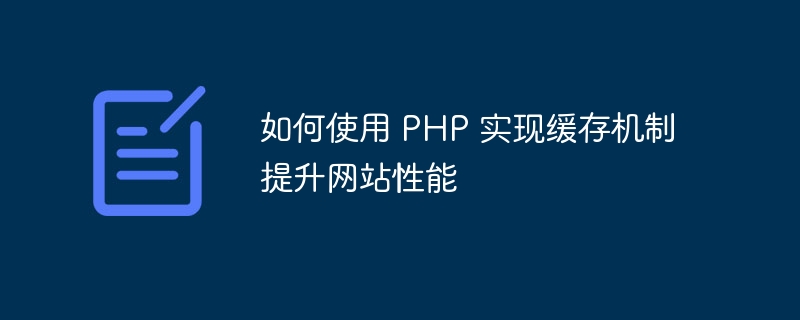Home >Backend Development >PHP Tutorial >How to use PHP to implement caching mechanism to improve website performance
How to use PHP to implement caching mechanism to improve website performance
- WBOYOriginal
- 2023-09-05 12:58:441367browse

How to use PHP to implement caching mechanism to improve website performance
Introduction:
When developing a website, improving website performance is an important consideration. The caching mechanism is an effective way to significantly reduce the load on the database and server and improve the response speed of the website. This article will introduce how to use PHP to implement a caching mechanism to improve website performance. The article will provide some practical code examples.
1. What is the caching mechanism?
The caching mechanism is to store frequently accessed or calculated data in a fast-access storage medium to reduce the number of accesses to the database or calculations. Common caching media include memory, file systems, etc. By using the caching mechanism, the response speed of the website can be greatly improved.
2. How to use the caching mechanism
- Page caching
Page caching stores dynamically generated web page content as a static HTML file, and directly returns the file when accessing again, and No need to generate again. You can use the following code example to implement page caching:
<?php
function getCacheKey($requestUrl) {
return md5($requestUrl);
}
function isCacheExpired($cacheFile, $expiryTime) {
return (time() - filemtime($cacheFile)) > $expiryTime;
}
function getPageFromCache($cacheFile) {
return file_get_contents($cacheFile);
}
function savePageToCache($cacheFile, $content) {
file_put_contents($cacheFile, $content);
}
$requestUrl = $_SERVER['REQUEST_URI'];
$cacheKey = getCacheKey($requestUrl);
$cacheFile = 'cache/' . $cacheKey . '.html';
$expiryTime = 60; // 缓存过期时间(单位:秒)
if (file_exists($cacheFile) && !isCacheExpired($cacheFile, $expiryTime)) {
echo getPageFromCache($cacheFile);
} else {
// 生成网页内容的代码
$content = generatePageContent();
echo $content;
savePageToCache($cacheFile, $content);
}
?>In the above code, first generate the cache key by getting the requested URL, and then check whether the cache file exists and whether it has expired. If the cache file exists and has not expired, the cached web page content is returned directly; otherwise, the content of the web page is generated and saved in the cache file.
- Data Caching
In addition to page caching, frequently accessed database query results or calculation results can also be cached. The following is an example that demonstrates how to use cache to store database query results:
<?php
function getCacheKey($query) {
return md5($query);
}
function isCacheExpired($cacheFile, $expiryTime) {
return (time() - filemtime($cacheFile)) > $expiryTime;
}
function getDataFromCache($cacheFile) {
return unserialize(file_get_contents($cacheFile));
}
function saveDataToCache($cacheFile, $data) {
file_put_contents($cacheFile, serialize($data));
}
$query = "SELECT * FROM users WHERE id = 1";
$cacheKey = getCacheKey($query);
$cacheFile = 'cache/' . $cacheKey . '.txt';
$expiryTime = 3600; // 缓存过期时间(单位:秒)
if (file_exists($cacheFile) && !isCacheExpired($cacheFile, $expiryTime)) {
$data = getDataFromCache($cacheFile);
} else {
// 执行数据库查询的代码
$data = fetchDataFromDatabase($query);
saveDataToCache($cacheFile, $data);
}
print_r($data);
?>In the above code, the cache key is first generated through the query statement, and then the cache file is checked to see if it exists and has expired. If the cache file exists and has not expired, the data is obtained from the cache; otherwise, the database query is executed and the results are saved in the cache file.
Conclusion:
By using the caching mechanism, the performance of the website can be greatly improved. Whether it is page caching or data caching, it can reduce the load on the database and server and improve the response speed of the website. I hope the sample code in this article can help you use the caching mechanism to improve website performance in actual projects.
The above is the detailed content of How to use PHP to implement caching mechanism to improve website performance. For more information, please follow other related articles on the PHP Chinese website!

